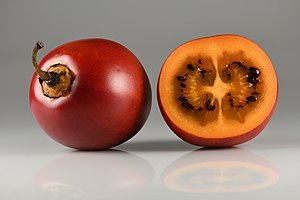Cookbook:Tamarillo
| Tamarillo | |
|---|---|
 | |
| Category | Fruits |
Cookbook | Recipes | Ingredients | Equipment | Techniques | Cookbook Disambiguation Pages | Ingredients | Fruit
The tamarillo or tree tomato is related to the tomato and tomatillo. It is egg-shaped and pointed at both ends. The skin is tough and bitter and may be red, purple, amber, or golden yellow in color. The outer layer of apricot-colored flesh is slightly firm and the inside is filled with dark edible seeds that are slightly harder than those of a tomato. The flesh is tangy and tart, but flavorful. Tamarillos are native to South America, but most tamarillos sold in the United States are imported from New Zealand. This fruit is popular in South and Central America, the Caribbean, parts of Asia, and Australia.
Selection
[edit | edit source]Select fruit that is firm, unblemished and is heavy for its size. When ripe, tamarillos should be fragrant and should yield slightly to gentle pressure. Tamarillos are available from May to October in specialty stores and some supermarkets. They can occasionally be found out of season.
Storage
[edit | edit source]Tamarillos may be ripened at room temperature, then stored in the refrigerator or eaten once they are ripe. They last up to ten days in the refrigerator if wrapped in a plastic. Tamarillos may also be frozen if they are peeled and wrapped individually.
Preparation
[edit | edit source]Tamarillos should be peeled before eating or cooking. Blanching in boiling water for 2 to 3 minutes is often the easiest way to remove the skin if the fruit is not ripe. They are often eaten raw, when ripe. Dip in frozen orange juice concentrate to sweeten the fruit and add to fruit or vegetable salads. Tamarillos are also often made into jams, chutneys and relishes.
